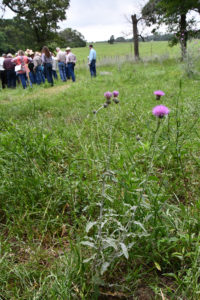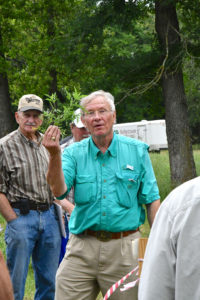AgriLife Expert: Lower feed bills by stockpiling, planting small grains crops

Media contact: Blair Fannin, 979-845-2259, b-fannin@tamu.edu
FRANKLIN — Stockpiling forages and feeding small grains crops year-round can help cattle producers offset the higher costs of hay.

That is the message from Dr. Larry Redmon, Extension program leader and associate department head for soil and crop sciences at Texas A&M University in College Station. His recommendations and others by Texas A&M AgriLife Extension Service specialists were part of walking demonstrations recently at the O.D. Butler Forage Field Day at Camp Cooley Ranch near Franklin.
Redmon said small grains forage crops should be planted six to eight weeks prior to the first frost of winter. He covered several small grains forage options for beef cattle producers to consider.
“You can limit graze,” Redmon said. “If you don’t live on the place and only come up during the weekends, you can turn the cattle in on the pasture if you come up on a Friday, then turn them off on Sunday before you leave.”
Redmon said small grains pastures can also help add weight to stocker calves.
“You usually wean your calves when they weigh five hundred pounds, so you have the opportunity to put an additional two hundred fifty pounds of gain prior to them entering the feedlot phase,” Redmon said.
When planting ryegrass in the South Central zone, Redmon recommends 55 pounds to the acre and letting stands grow until May before beef cattle grazing. Another option, clover, can help save dollars on nitrogen application by releasing it naturally into the soil. Redmon said clover can help save nitrogen expense at about 60 cents per pound of nitrogen.
For upland regions that have sandy soils, Redmon recommends Arrowleaf clover varieties. For the Blacklands region, Burr medic. White clover varieties do well in wet regions.
Dr. Tony Provin, AgriLife Extension soil chemist in College Station, provided an overview on soil health; heavy rainfall this spring has brought an onslaught of weeds.


“Weeds ruck up moisture and nutrients, preventing deeper root growth establishment for forages,” he said.
Provin said producers need to be mindful of Ph levels in soils and should consider distributing limestone to offset deficiencies. To stay on top of soil health, Provin advised taking annual soil tests to monitor Ph levels.
“The key is to plan and stay on top by monitoring soil health annually,” he said. “It can take three to four years to get the appropriate response needed for limestone.”
The annual forage field day event is coordinated by AgriLife Extension in conjunction with area Extension county offices and the Brazos Area Hay Producers Association.


